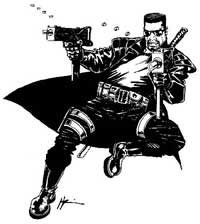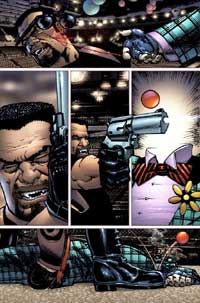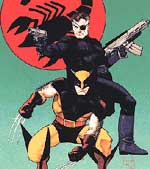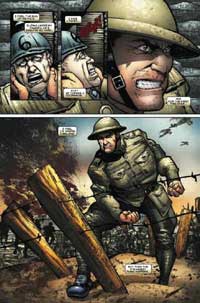Comics /
Cult Favorite
Who Wants To Live Forever?
By Philip Schweier
February 23, 2008 - 16:48
It's hard to believe that 2008 is here, and with the rapid passage of time, one's thoughts might turn to question our own mortality. While it may be a given for most characters, Marc Guggenheim and Howard Chaykin explored various aspects of life, death, the after-life and being un-dead, first in their 12-issue series
Blade, and later in the pages of
Wolverine. Both characters have, as one Highlander put it, a problem dying.
Guggenheim began as an intern at Marvel Comics in 1990, but has since
 |
| Howard Chaykin |
 |
| Marc Guggenheim |
become a successful television writer for shows such as
The Practice, Law & Order and
CSI: Miami. Chaykin has been in the comics industry since the 1970s, having illustrated the Marvel Comics adaptation of the original
Star Wars film before achieving critical acclaim with his own creation,
American Flagg! from First Comics in 1983. He also has worked in television, most notably on the short-lived
Flash TV series, but has returned to comics, and since then he's been having the time of his life.
Though the
Blade movies starring Wesley Snipes have been very successful in drawing attention to the character, it is after all a horror title, and the genre has always been a tougher nut to crack in comics. Nevertheless, Guggenheim chose to approach the series with a sense of fun.
When invited to illustrate the series, Chaykin appreciated Guggenheim's approach to the story, as well as the material's political elements. "There seemed to be some simpatico in how we approach the storytelling and the material," he tells
comicbookresources.
When Marvel Comics announced that Chaykin would be the artist for
Blade, Guggenheim, a long-time fan of the artist's work, is quoted as saying, "I think Howard's the perfect choice for
Blade. Let's be honest, his involvement brings a level of cache, of class to the project that I don't. Moreover, he's the pitch-perfect choice given what we're trying to do with this new
Blade series, which is to appeal to both fans of horror and super-hero action alike."
The story follows Blade as he is used in a political game, traveling from New York to London to Latveria. His father manipulates him in pursuit of prophecy that may or may not have an everlasting effect on the vampire community of the Marvel Universe. Along the way, Blade encounters old friends such as Spider-Man, Wolverine and Hannibal King, and old enemies such as Dracula and Morbius.
New readers are also treated to a series of flashbacks that reveal pieces of the Daywalker's origins, much like a previously-mentioned TV series dealing with immortal beings.
Guggenheim credits Chaykin's professionalism with the clockwork-like timing of the book. "He's a total gentleman and a consummate professional. His pages come in brilliant and they come in like clockwork," he says in an interview at
yourmomsbasement.com. "Our first 12 issues (came) out in the span of 12 months and (were) produced by the exact same creative team. That's a rare accomplishment these days and it could only have been achieved through the involvement of an artist of Howard's artistic and professional caliber."
Chaykin has high praise for his collaborator. "(Marc's) one of the most artist-friendly writers that I've ever worked with," he told
Newsarama. "He knows how to get exactly what he wants from me, in the best possible way. Drawing his stuff is a treat."
Having the opportunity on something like
Blade was a great challenge, one aspect of which was making the book current, and Chaykin feels a responsibility as an illustrator to allow for contemporary sensibilities. As such, he makes an effort to include a great deal of reference and research in his designs, such as settings and fashion.
Another challenge was a scene involving Blade's reflection – or lack thereof, given his vampiric heritage. Many writers and artists adopt a clearcut "what-you-see-is-what-you-get" approach, but instead, Guggenheim and Chaykin chose to present something a little more visually complex, requiring the reader to pause a moment longer and suss out the visual elements and their relationship to the literary.
Guggenheim and Chaykin followed up with a stint on
Wolverine (#57-61), a character both had worked with before, most recently in
Blade #5. A fan since the John Byrne era of the X-Men, Guggenheim had written seven issues (#42-48) of the title previously, while Chaykin had worked with Archie Goodwin on an original graphic novel,
Wolverine/Nick Fury: The Scorpio Connection in 1990.
In their five-issue story arc, entitled "Logan Dies," they explore the limits of Wolverine's regenerative abilities. How dead is too dead? It requires a catastrophic event to take him to the edge of his mortality, in this case, a grenade down the gullet.
But this time, when the healing factor has done its work, Wolverine remains brain-dead. Guided by Dr. Strange, Logan's soul must battle Azrael, an angel of death whom he first faced almost a century ago. Since then, their duel has been refought each time Logan has come to the brink of death. Should Logan lose, his life is truly forfeit.
But Azrael is just the opening act. Also in the mix is Phaedra, a woman responsible for bringing Logan back to life in the past, and now she's brought an old enemy back as well, along with a mysterious unstoppable assassin.
In the end, Logan's sharpest weapon is not his claws, but his mind, and his own will to survive. But can a woman who has the power over life and death be truly defeated? The ending is left rather open for further exploration.
Praise and adulation? Scorn and ridicule? E-mail me at
philip@comicbookbin.com . Corrections are always welcome.
Last Updated: March 3, 2025 - 20:40





